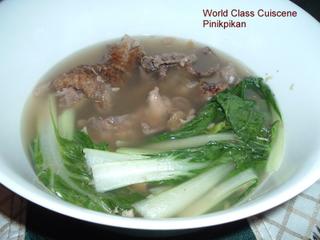Pinikpikan
I meant to write about Pinikpikan after returning from Bagiuo. What is Pinikpikan? Well, it’s a Bagiuo delicacy that I semi-witnessed while walking down a street on a cool, pleasant morning in Bagiuo. But I’ll let this website explain –Not for people with weak hearts.
Ever heard of pinikpikan? This is one of the most exotic food of the people from the highland provinces of the Philippines. Sometimes we call it the "killing-me-softly" recipe because of the way this is preparped before being cooked. The following may not exactly be the way the Igorots do it but this is my son's instructions the way my son saw the guys prepared it.
Put one wing of a chicken on a flat surface. Hold the head, one wing, and the legs in the one hand. Using a club softly beat the other wing from the inside. Beat it so it does not break the bones. Beat the wing from the inside to the tip, and then back again. You must do this twice. Repeat for the other wing. After beating the wings, lay the head of the chicken, on the flat surface, facing one way. Beat the neck from the top to the bottom. You may probably wonder why the chicken has to be beaten. The reason to beat the chicken is to make the blood coagulate on the wings and on the neck. The wings get thick and look big when cooked. It is said that it tastes better as well. Another reason is when the blood coagulates, you then have to butcher the chicken, and blood does not drip as much. If done right, there would be very little blood dripping to the ground.
Now you must kill the chicken. To kill the chicken, hold the chicken firmly by the feet and wings in one hand. Use a club to hit the back of its head, just below the comb. Not too hard, or the chicken will bleed. One blow should do it. Use a torch or fire, burn the feathers off. Keep burning the chicken until it starts to look a little bit burnt. Don't worry, the burnt look is only at the surface because it was only the feathers that got burnt.
Once the feathers are burnt off remove the remaining feathers. Use tweezers if necessary to remove the roots of the feathers. My dad is not an Igorot that's why he does that, but the real Igorots don't bother removing them anymore. Clean the inside of the chicken and then cut the chicken into medium sized pieces and put them into a pot. Add etag if you have any. Cook on high heat until meat is tender. When the chicken is done, add chayote or any vegetables of your choice into the pot. Add salt and remove the pot from the heat. Keep covered. Leave for four minutes minutes. Stir the soup and enjoy.
** To make etag, get a side of bacon and slice it into squares about an inch long. Dredge the meat in coarse salt and put in a ceramic bowl. Cover it and let it dry in open air for about 3 days. Keep in a dry container for about 3-5 weeks.**

And yes, to confirm the chicken is alive when they beat it! When my workmates first described this to me I thought they meant that the chicken was dead when it was beaten. But no! Walking down the street in Baguio we saw a Pinikpikan store. There were live chickens in cages and we saw some people buying the end product of a charcoaled chicken still with its feathers and everything! After thinking that it wouldn’t be too bad to try this local delicacy, I decided that it may just be one of those foods that I’ll pass on please.
More pleasurable is another Pinikpikan, a local Baguio band comprised of local artists playing local instruments. Here’s the story: It all started in 1989 at the first Baguio Arts Festival, Baguio City, home to many of the Pinikpikan - Participating artists from Manila had joined up with members of the Baguio Arts Guild at a dinner at Cafe by the Ruins after the festival's opening. As they sat around the Cafe's Dap-ay (a circular rock and stone installation found in tribal villages in the northern Cordillera where elders hold their council and rituals) someone picked up a couple of pieces of pinewood meant for the fire raging at the center. Another picked up some bamboo segments. Rum and beer bottles were used. So were covers of pots and pans. Rocks were pounded. Sticks flailed. A rhythm was born. Very Igorot in its influence. Then the rock band The Blank joined with lead and bass guitars. A keyboard was set up. A couple of guys brought out their saxophone and flutes. Manong Bencab called them the Pinikpikan, after a Mountain Province chicken dish which is prepared with an Igorot beat.
Macel, Chi and I ate breakfast at Café by the Ruins where I bought one of their CDs. It’s a beautiful café and much more enjoyable and friendly to the animals than it’s namesake! (Although Neil isn’t a big fan of some of the wailing . . .)






<< Home